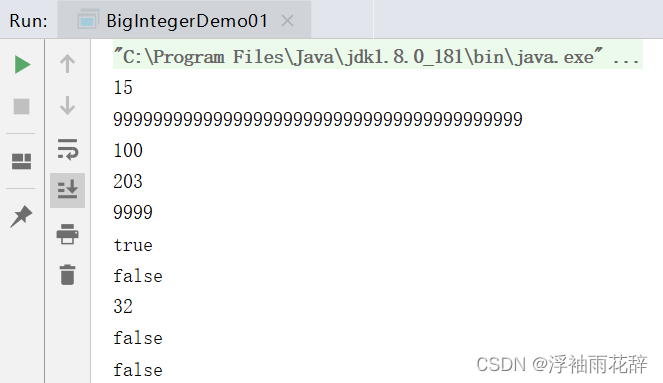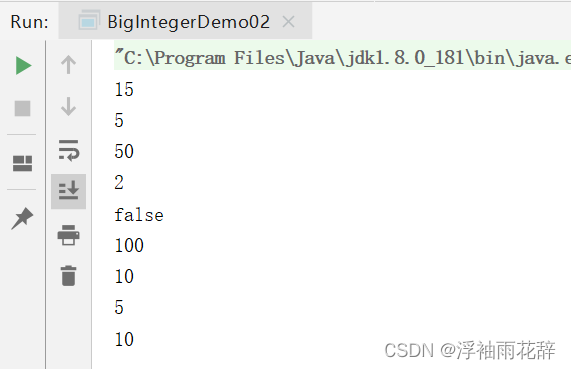Biglnteger
public BigInteger(int num, Random rnd) 获取随机大整数,范围:[0~2的num次方-1]
public BigInteger(String val) 获取指定的大整数
public BigInteger(String val, int radix) 获取指定进制的大整数
public static BigInteger valueOf(long val) 静态方法获取BigInteger的对象,内部有优化
对象一旦创建,内部记录的值不能发生改变。
针对BigInteger(String val, int radix)补充细节:字符串中的数字必须是整数;字符串中的数字必须要跟进制吻合;比如二进制中,那么只能写0和1,写其他的就报错。
针对static BigInteger valueOf(long val)补充细节:能表示的范围比较小,在long的取值范围之内,如果超出long的范围就不行了。在内部对常用的数字(-16~16)进行了优化。提前把-16~16先创建好BigInteger的对象,如果多次获取不会重新创建新的。
下面将代码实现:
package com.itheima.biginteger;
import java.math.BigInteger;
import java.util.Random;
public class BigIntegerDemo01 {
public static void main(String[] args) {
//获取一个随机的大整数
BigInteger bd1 = new BigInteger(4,new Random());//[0,15]
System.out.println(bd1);
//获取一个指定的大整数
BigInteger bd2 = new BigInteger("99999999999999999999999999999999999999999");
System.out.println(bd2);
//获取一个指定进制的大整数
BigInteger bd4 = new BigInteger("100",10);
BigInteger bd5 = new BigInteger("11001011",2);
System.out.println(bd4);
System.out.println(bd5);
//静态方法获取BigInteger对象,内部有优化
BigInteger bd6 = BigInteger.valueOf(9999);
System.out.println(bd6);
BigInteger bd7 = BigInteger.valueOf(16);
BigInteger bd8 = BigInteger.valueOf(16);
System.out.println(bd7 == bd8);//地址相同
BigInteger bd9 = BigInteger.valueOf(17);
BigInteger bd10 = BigInteger.valueOf(17);
System.out.println(bd9 == bd10);//地址不同
//对象一旦创建,内部的数据不能发生改变
BigInteger result = bd7.add(bd8);
System.out.println(result);
System.out.println(bd7==result);
System.out.println(bd8==result);
}
}
运行结果:

#总结:如果BigInteger表示的数字没有超出long的范围,可以用静态方法获取。如果BigInteger表示的超出long的范围,可以用构造方法获取。对象一旦创建,BigInteger内部记录的值不能发生改变。只要进行计算都会产生一个新的BigInteger对象。
Biglnteger常见成员方法

代码实现:
package com.itheima.biginteger;
import java.math.BigInteger;
public class BigIntegerDemo02 {
public static void main(String[] args) {
//创建两个BigInteger对象
BigInteger bd1 = BigInteger.valueOf(10);
BigInteger bd2 = BigInteger.valueOf(5);
//加法
System.out.println(bd1.add(bd2));
//减法
System.out.println(bd1.subtract(bd2));
//乘法
System.out.println(bd1.multiply(bd2));
//除法,获取商
System.out.println(bd1.divide(bd2));
//比较是否相同
System.out.println(bd1.equals(bd2));
//次幂
System.out.println(bd1.pow(2));
//返回较大值
System.out.println(bd1.max(bd2));
//返回较小值
System.out.println(bd1.min(bd2));
//转为int类型整数,超出范围数据有误
int i = bd1.intValue();
System.out.println(i);
}
}

接下来单独看一下:public BigInteger[] divideAndRemainder(BigInteger val)
package com.itheima.biginteger;
import java.math.BigInteger;
public class BigIntegerDemo03 {
public static void main(String[] args) {
BigInteger bd1 = BigInteger.valueOf(10);
BigInteger bd2 = BigInteger.valueOf(5);
//除法,获取商和余数
BigInteger[] arr = bd1.divideAndRemainder(bd2);
System.out.println(arr[0]);
System.out.println(arr[1]);
}
}
运行结果:

结果显示,数组的第一个数据是商,第二给数据是余。





















 2156
2156











 被折叠的 条评论
为什么被折叠?
被折叠的 条评论
为什么被折叠?








